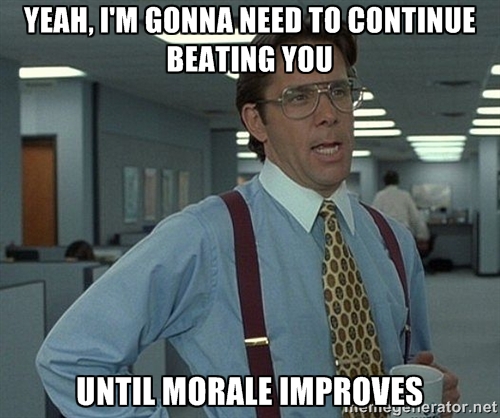For some combination of reasons – budget, availability, timing – your company’s decided to rely on you and a team of bright-eyed do-gooders (re: millenials) to make a video or 20. You’re up for the challenge, no bid deal. You’re well-versed in project management and coordinating logistics. You’re a people person. How hard could directing your co-workers be?
Then you remember the content of the video. It features your colleagues. Last you checked, you didn’t work with Meryl Streep or Denzel Washington. None of them have ever appeared in front of a camera before except that one time Susan from accounting helped rescue her neighbor’s trapped beagle and the news profiled her. On top of that, you realize your directorial résumé makes Charles Laughton’s look prolific. Suddenly, things aren’t so easy.
Practice Beforehand
Rehearsals are necessary. Emphasize the important of practicing lines – even if it’s for a few minutes a day – well before you start rolling. More frequent exposure to the material increases the likelihood of greater familiarity and internalization by the time you start filming.
It’s more than just your voice; posture, body movement, hand gestures, and eye contact are very important communicative cues you share with audiences. Practicing mindful camera presence leads to higher quality output. If it looks and feels natural, it will go unnoticed. That’s what you want.
Start Small and Simple
We crawl, sway, and stand before we learn to walk. So why do we hand over a four paragraph treatise full of technical details to Steve, marketing manager, to regurgitate on camera?
That’s a lot of information to cover. It’s an even bigger challenge if that’s the first scene Steve encounters. Cut the excess from Steve’s spiel and focus on communicating value to your buyer personas.
So how can you avoid this quagmire?
-
Script your videos with end-user benefits in mind
-
Develop a flexible shooting schedule.
A flexible shooting schedule allows you to film scenes out of order as they would appear in a script. For example, consider recording your beginning and ending first because they’re less wordy and memory-intensive for Steve. Once he’s capable, you’ll tackle the middle section last. Gauge what sections he really feels comfortable with and which are daunting.
Articulate What You Want
“Move over there.”
“Can you do it again?”
Vague instructions waste time. Your co-workers are left trying to read your mind or guess the best course of action. You might get more frustrated and annoyed when his or her understanding falls short of your intentions. Clearly and concisely explain what results you want with specific examples.
Instead of “move your body this way”, try:
“Tilt your chin up one inch. Square your shoulders to the camera. Step back one foot and keep your hands folded in front of you.”
Yes, this method can be time-consuming. But you will save more time conveying details immediately than re-shooting the same scene 50 times.
Allow Room for Interpretation
You’re going to stick to the script word for word in most instances. However, what’s written and what’s recorded can vary. Maybe your colleagues come off as too robotic or cold when following the teleprompter. Maybe he or she adds in some extra words or pauses that alter the rhythm. Maybe he or she subtracts something. Maybe they’re just having trouble reciting a truckload of information within time constraints.
Allocate a little room for “experimentation” at first when your subject is getting acclimated to being on camera. Your performers can build on that initial confidence when warming up. Soon, they will give you what you need. The best part is that you don’t have to run with these “practice” takes if you’re adamant on reproducing your script verbatim. Let them overcome their anxieties and then capture their best work.

Reduce Stressful Surroundings
Come production day, is your set a whirlwind of chaos? Are all the pieces and people in place? Are you in control? Are you too controlling?
A tense, volatile atmosphere finds its way into your non-actors’ readings. They likely want to get their lines over with as soon as possible so that they can avoid witnessing an awkward meltdown when you trip over an extension cord and face-plant into a fern. Their mistakes may exacerbate an already tumultuous day. Don’t let that happen. Plan well in advance and delegate duties to trusted cohorts. Lead by example with a positive, reassuring demeanor. Voice feedback in a fair, professional tone.
What little things can be done during filming to maximize positive energy?
-
Play music when you’re not shooting
-
Provide snacks and refreshments
-
Stretch or allow jittery teammates to move around
-
Designate a quiet area or separate space away from the action for people to practice or unwind
-
Have teammates post behind the scenes or “making-of” content on social channels
Listen
You aren’t the only person watching what’s unfolding. Ask your co-workers for their perspectives. They’re likely standing next to you or actively participating (e.g. holding the mic). Perhaps they’ve noticed some nuances undetected by you.
Survey your participants a couple days after you’ve completed your video. What worked for them? What didn’t? What do they recommend adding or subtracting to make the process better? You become a better director, communicator, and leader the more you listen.
The context for filming non-actors and directing your co-workers is vastly different compared to coaching professional talent you hire. That’s not to say amateurs cannot deliver effective performances. It’s just re-calibrating your expectations to accommodate for a different margin of error and working style. Improvements are usually implemented in future video shoots after painfully encountering recurring problems. Be on the lookout as early as possible for potential roadblocks and have the courage to improvise or pivot as you see fit. Trust me, it’s a lot more fun than it sounds.



